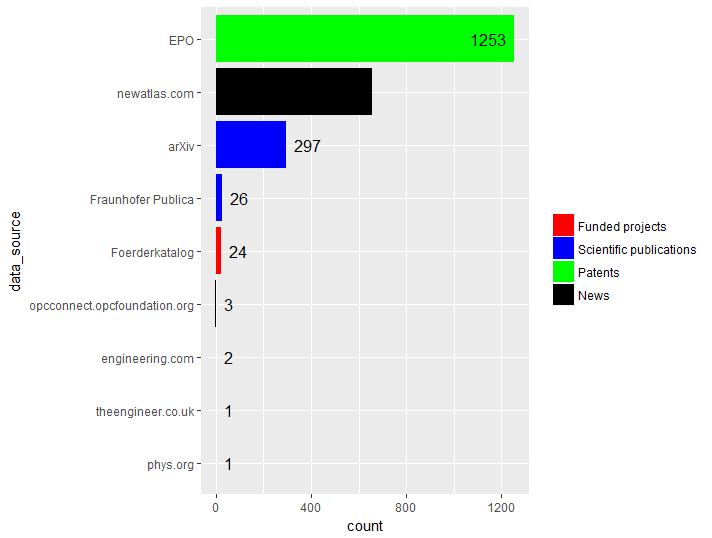Hi guys!
The following plot is what I want to get.
da <- structure(list(data_source = structure(c(3L, 6L, 1L, 5L, 4L,
7L, 2L, 8L, 9L), .Label = c("arXiv", "engineering.com", "EPO",
"Foerderkatalog", "Fraunhofer Publica", "newatlas.com", "opcconnect.opcfoundation.org",
"phys.org", "theengineer.co.uk"), class = "factor"), data_type = structure(c(3L,
2L, 4L, 4L, 1L, 2L, 2L, 2L, 2L), .Label = c("FUNDING_PROJECT",
"NEWS", "PATENT", "SCIENT_PUBLICATION"), class = "factor"), count = c(1253L,
656L, 297L, 26L, 24L, 3L, 2L, 1L, 1L)), .Names = c("data_source",
"data_type", "count"), class = "data.frame", row.names = c(NA,
-9L))
plotData <- da
library(ggplot2)
library(dplyr)
# plotData <- da %>%
# arrange(count) %>%
# mutate(
# data_source = factor(data_source, levels = data_source),
# data_type = factor(data_type, levels = c("FUNDING_PROJECT",
# "SCIENT_PUBLICATION",
# "PATENT","NEWS"))
# )
plotData[["data_source"]] <- factor(plotData$data_source, levels = arrange(plotData ,plotData$count)$data_source)
# Make cVal column a factor with specified levels
plotData[["data_type"]] <- factor(plotData[["data_type"]],
levels = c(
"FUNDING_PROJECT",
"SCIENT_PUBLICATION",
"PATENT",
"NEWS"))
# Initialise ggplot
p <- ggplot(plotData)
# Plot bar chart
p <- p + geom_bar(aes_q(x = as.name("data_source"),
y = as.name("count"),
fill = as.name("data_type")),
stat = "identity",
position = position_dodge())
# Add values as labels on bars
plotData <- cbind(plotData, yLabel = paste0(" ", plotData[,"count"], " "))
p <- p + geom_text(data = plotData,
aes_q(x = as.name("data_source"),
y = as.name("count"),
label = as.name("yLabel"),
hjust = "inward"),
size = (5/14)*12 # conversion from mm to px
)
# Assign colours to data types
p <- p + scale_fill_manual(name = "",
values = c(
"FUNDING_PROJECT" = "red",
"SCIENT_PUBLICATION" = "blue",
"PATENT" = "green",
"NEWS" = "black"),
labels = c(
"FUNDING_PROJECT" = "Funded projects",
"SCIENT_PUBLICATION" = "Scientific publications",
"PATENT" = "Patents",
"NEWS" = "News"))
# Flip coordinates
p <- p + coord_flip()
plot(p)
I also try to use googleVis to get the plot. But I do not know how to set the color. And I think the legend will be hard to set too.
da <- structure(list(data_source = structure(c(3L, 6L, 1L, 5L, 4L,
7L, 2L, 8L, 9L), .Label = c("arXiv", "engineering.com", "EPO",
"Foerderkatalog", "Fraunhofer Publica", "newatlas.com", "opcconnect.opcfoundation.org",
"phys.org", "theengineer.co.uk"), class = "factor"), data_type = structure(c(3L,
2L, 4L, 4L, 1L, 2L, 2L, 2L, 2L), .Label = c("FUNDING_PROJECT",
"NEWS", "PATENT", "SCIENT_PUBLICATION"), class = "factor"), count = c(1253L,
656L, 297L, 26L, 24L, 3L, 2L, 1L, 1L)), .Names = c("data_source",
"data_type", "count"), class = "data.frame", row.names = c(NA,
-9L))
#> structure(list(data_source = structure(c(3L, 6L, 1L, 5L, 4L,
#> 7L, 2L, 8L, 9L), .Label = c("arXiv", "engineering.com", "EPO",
#> "Foerderkatalog", "Fraunhofer Publica", "newatlas.com", "opcconnect.opcfoundation.org",
#> "phys.org", "theengineer.co.uk"), class = "factor"), data_type = structure(c(3L,
#> 2L, 4L, 4L, 1L, 2L, 2L, 2L, 2L), .Label = c("FUNDING_PROJECT",
#> "NEWS", "PATENT", "SCIENT_PUBLICATION"), class = "factor"), count = c(1253L,
#> 656L, 297L, 26L, 24L, 3L, 2L, 1L, 1L)), .Names = c("data_source",
#> "data_type", "count"), class = "data.frame", row.names = c(NA,
#> -9L))
library(googleVis)
#> Creating a generic function for 'toJSON' from package 'jsonlite' in package 'googleVis'
#>
#> Welcome to googleVis version 0.6.2
#>
#> Please read Google's Terms of Use
#> before you start using the package:
#> https://developers.google.com/terms/
#>
#> Note, the plot method of googleVis will by default use
#> the standard browser to display its output.
#>
#> See the googleVis package vignettes for more details,
#> or visit http://github.com/mages/googleVis.
#>
#> To suppress this message use:
#> suppressPackageStartupMessages(library(googleVis))
p <- gvisBarChart(da, xvar = "data_source", yvar = "count" )
plot(p)
#> starting httpd help server ...
#> done
Thank you.
Song

